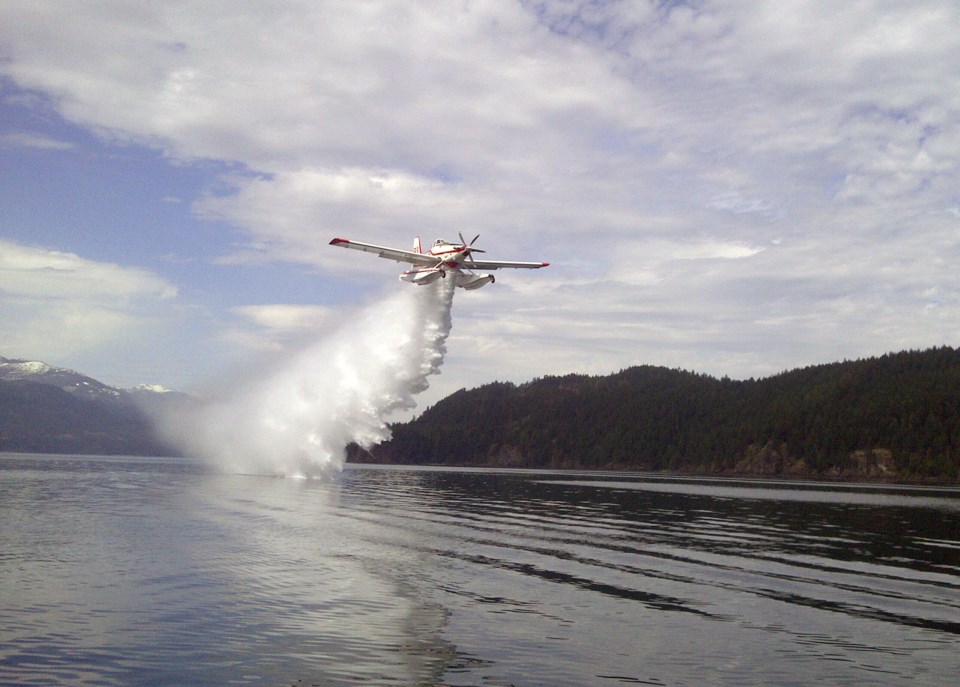Fire season is now well underway, which means the water bombers are now stationed at the Air Tanker Base west of the Lac La Biche Airport for the summer.
Six amphibious airplanes are parked on the tarmac at the base, ready to take to the skies in the event of a wildfire.
When they’ re not bringing air superiority to bear, the pilots are still “on alert,” ready to leave inside of an hour or within five minutes, depending on the level of risk for wildfires in the area.
Pilot Rob Maksymetz, who is currently serving his sixth season as an air tanker pilot, says the group may be called to respond to a wildfire as many as 40 or 50 times during a season, although not all calls lead to actual firefighting efforts on their part.
“It really depends on the fire season that we’ re having,” said Leslie Lozinski, information officer for the Lac La Biche Forest Protection Area, which extends from the hamlet of Lac La Biche as far north as Anzac and from the Saskatchewan border to just west of Athabasca. “It’ s weather-dependent.”
When the pilots do respond, they’ re led by an air attack officer, who pilots a speedier aircraft and thus can reach the site of the wildfire sooner.
Lozinski says the air attack officer coordinates the airborne firefighting efforts, communicating with emergency response crews on the ground and directing the other pilots.
Normally, the air tankers leave the base with loads of fire retardant. Later, the tankers take water from nearby lakes as needed, she says.
“The retardant is more for containing the fire, and then the water is for suppressing it,” said Maksymetz.
There are certain “attack patterns” that the pilots employ when combating a fire from above, such as dropping water and retardant in front of it to keep it from advancing or behind it in order to box it in.
When they’ re not in the air but still at work, the pilots spend time at the tanker base at their leisure, although, depending on the level of wildfire risk, they may be required to be wearing their coveralls and ready to leave to at a moment’ s notice.
It takes a certain degree of experience in order to be an air tanker pilot, Maksymetz says.
“Most of us that come here have vast experience flying,” he told the POST, pointing out that the pilots stationed in Lac La Biche have gravitated here from across the country. One is a retired airline pilot.
In addition to the rigours of flying for a living, the job can be mentally demanding, Lozinski says.
“Any wildfire fighting job can be stressful,” she said. “It takes a well trained individual with instinctive decision making and reactions to thrive in this environment.”
“It’ s challenging but it’ s rewarding,” Maksymetz said.
Lozinski says flying in any kind of formation, as the air tankers do, is difficult and requires discipline. In her words, “One pilot can’ t go left when the others go right.”
There are times when things have not gone according to plan.
“There are always surprises over a fire,” said Maksymetz, who added that the pilots undergo flight tests and simulated training exercises as part of their preparations for their work.
All of the pilots’ operations are carried out with safety in mind, he says.
When the air tankers need to take water from lakes, a one-mile stretch of water at least five feet deep is optimal, Lozinski says.
The airplanes are amphibious, so they can skim along the water’ s surface in order to fill their tanks.
“It can be challenging,” Maksymetz said. “Lake conditions can change. Boaters can get in the way, but they have got better over the years.”
The group of air tankers and their pilots in Lac La Biche are one of nine such groups throughout Alberta. The Lac La Biche squadron is actually a double group, Lozinski says. The only other double group is stationed in Slave Lake.
“Some of the other groups have larger but fewer planes,” Lozinski said.
Although the group flies from Lac La Biche, it is not unheard of for the pilots to be called into other areas.
Two particularly memorable wildfires, as Maksymetz recalled, were outside of the Lac La Biche Forest Protection Area. One was among the sand dunes north of Fort McMurray, and the other was near the community of Nordegg, west of Red Deer.
The number of air tankers assigned to Lac La Biche is a decision made by Environment and Sustainable Resources officials, Lozinski says, based on the abundance of nearby lakes, the number of wildfires in a typical fire season and access to other resources.



